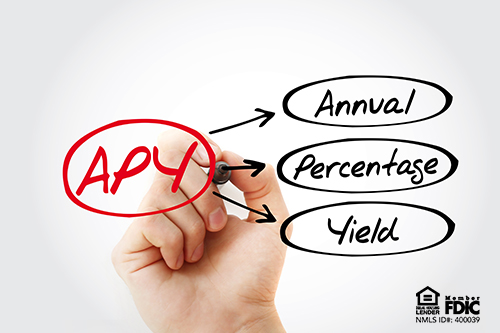Knowing the terms and rates of various account types is crucial to saving money effectively. One term that often confuses is APY or annual percentage yield.
This blog will explain APY and discuss how it differs from other rates. Additionally, it will highlight the importance of knowing APY when choosing a savings account.
What is APY?
APY is the yearly interest percentage you earn on a deposit. This includes the interest earned on the initial deposit, compound interest, and any interest earned on the interest itself. APY is the total money you will earn on your deposit over a year.
How is APY Calculated?
A formula determines APY by considering the interest rate, compounding periods per year, and the initial deposit. The formula is as follows:
APY = 100 [(1 + Interest/Principal)(365/Term in days) - 1]
For instance, consider a 12-month certificate of deposit worth $1,000 that yields $30.00 in interest over a year. First, divide the interest earned ($30.00) by the principal amount ($1,000) to get 0.030, then add 1 to get 1.030.
Next, divide 365 by the term length in days, 365 in this case, to get 1. Multiply 1.030 by 1 to get 1.030. Subtract one from this to get 0.030. Lastly, multiply 100 by 0.030 to calculate the APY, which is 3%.
How is APY Different from Other Rates?
People often confuse APY with other rates, such as interest and dividend rates. It is essential to understand the differences because these rates are related but not the same.
Interest Rate
The interest rate applies a percentage of interest to your initial deposit. APY or dividend rate are the rates most banks and credit unions advertise. It calculates the interest you'll earn on your deposit. The interest rate doesn't account for compounding periods, so it doesn't accurately show your yearly interest earnings.
Dividend Rate
The dividend rate is a term used for interest earned on deposits in a credit union. The credit union uses it specifically, essentially the same as the interest rate. The interest rate does not consider compounding periods. Therefore, it does not accurately show the total annual interest earned.
APY vs. Interest Rate and Dividend Rate
APY considers compounding periods, while other rates do not. This means that APY is a more accurate representation of the total interest earned over a year. The APY always equals or exceeds the interest or dividend rate. This is because it includes the interest earned on the interest.
Why is APY Important?
Understanding APY is essential for a few reasons. Compare savings accounts to find the one that earns the most money for you in the long run. Consider the interest rate and how often it compounds to determine the overall annual percentage yield (APY).
Additionally, understanding APY can help you make informed decisions about how to save and invest your money.
For example, suppose you are choosing between a savings account and a certificate of deposit (CD). The CD has a higher APY but requires keeping funds held for a period of time. A CD might be better if you don’t mind having your money locked up longer.
How Can I Maximize My APY?
Now that you understand what APY is and how it differs from other rates, you may be wondering how you can maximize your APY. Here are a few tips to help you earn the most interest on your savings:
Look for High APY Accounts
When choosing a savings account, compare APYs from different banks and credit unions. Look for accounts with the highest APYs to ensure you earn the most interest on your money.
Consider Different Compounding Periods
As mentioned earlier, the compounding periods can significantly impact the APY. While most savings accounts compound monthly, some compound daily or even annually. Be sure to consider the compounding periods when comparing APYs.
Keep Your Money in the Account
It is important to keep your money in the account for the entire year to earn the most interest. If you withdraw funds before the end of the year, you will not earn the full APY.
Consider a CD or Money Market Account
CDs and money market accounts often offer higher APYs than traditional savings accounts. However, they may have restrictions on when you can withdraw your funds. Consider your financial goals and needs before choosing one of these accounts.
Conclusion
Understanding APY is essential for saving money. It shows how much interest you'll earn on your deposit in a year and helps you compare different savings accounts. Learn about APY and follow the tips in this blog to earn more and make the most of your savings.
If you want to learn more about the savings accounts available through NASB, click here or visit one of our branches.




